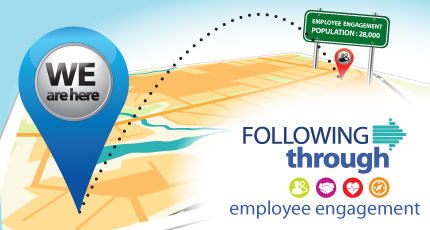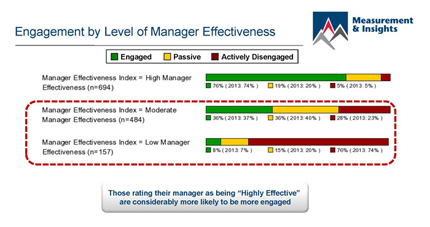
| WRHA Staff & Health Professionals Home |
 |
|
A message from Dave Leschasin March 2015 If you are one of the 44 per cent of people who took the time to provide your thoughts on your workplace, thank you. Participation and engagement numbers went up in the Region by two per cent across the board. As a Region, of the people who responded, 56 per cent of you told us you’re engaged. What else did we learn? You told us we’re going in the right direction by enhancing support to managers. We didn’t think we’d see the impact yet but manager scores notably went up from 62 per cent to 69 per cent engaged. While they are not where they need to be - I’d like to see them over 85 per cent - we’re heading in the right direction. That’s going to continue to be our focus. Why? Because employees don’t leave jobs, they leave their managers. There is research to back up that statement. We have our own data to back that up. Take a look at this picture, which demonstrates what you told us about the impact of manager effectiveness on employee engagement: When a manager is effective, employees are more likely to be engaged. The reverse is also true - when employees feel their manager is ineffective, they are more likely to be actively disengaged. You told us this needs our attention. The top two drivers of engagement requiring attention, according to your feedback, are driven by managers: managing performance and recognition. It’s important to note that having too large a number of people who report to a manager (span of control) is a unique problem within healthcare, when compared to other industries. The large number of employees reporting to each manager is an issue throughout the Region. That means managers are expected to do a lot in their people management role - it doesn’t necessarily mean they’re “bad managers”. It’s no surprise that improving manager effectiveness was one of the five areas AON Hewitt recommended we focus on. You can read more of their recommendations here. This information gives us a starting point, but it doesn’t tell us what the root causes are. There is no magic pill to wait for; you know which units are struggling. My advice to leadership teams is to pick the three units in their organization with the lowest engagement and/or high active disengagement, which are struggling the most. I’ve encouraged leadership and HR teams to get in there, talk to the employees, find out the root cause, and fix the problem. Most times your leadership team or manager can fix it. For example, we ourselves faced this challenge in the HR department and focused on it. Click here to read what we did in HR Another theme common throughout the Region is resource issues: we’re trying to do too much with too little. When everything’s a priority, nothing’s a priority. Adding resources (people, IT systems, equipment, etc.) to solve every issue is not affordable. That’s why I’ve been trying to encourage managers - particularly senior executives, who can set the tone for a site or portfolio - to prioritize, which includes making the difficult decisions to drop or delay some current priorities. Saying no is hard. I know we want to please our stakeholders and the people we provide care to but we can’t do that at risk of overburdening and burning out our managers and employees. We are a service industry. Our people are our most important resource. You can’t perform at your best if we keep piling things on and follow through on every idea that comes our way. Your health suffers. Your work suffers. Patient care suffers. And that’s not a good scenario for anyone. Given financial constraints, prioritizing, along with other initiatives such as applying LEAN to solve problems, eliminate waste and improve processes, are actionable steps that can have an impact on resources issues in a positive way. I believe span of control issues (too many employees reporting to a manager) need to be addressed first. You can make the best selection of the person to do the manager job, and have the best training, but if their span of control is too big, it’s pointless. We’re working on addressing what you told us, on looking at areas where there are issues. Fixing some of these concerns in one year isn’t realistic. It may take anywhere from three to five years to see changes on a bigger scale, particularly where culture change is required. You told us we’re moving in the right direction. And we’ll keep working to make things better. Until we have data from you that turns a corner to strong engagement levels of 65 per cent or more, we’ve got work to do. If you haven’t seen or heard results for your department, site or portfolio, talk to your manager or HR. It’s important to survey every year to see if our efforts have made a difference and to remind us where greater effort is needed. We’ll be asking you again in October to tell us what you think. I invite you to participate, because what you tell us is important. To those of you who are engaged? Thank you - and keep doing what you’re doing. Your work, commitment and input makes a difference each and every day. To those of you who aren’t there yet? Thank you for letting us know . . . we’re listening. Dave Leschasin Further reading |
 |
This site is not intended to be used by the general public. If you are not a health care professional or a WRHA staff member, please refer to our public website. |
